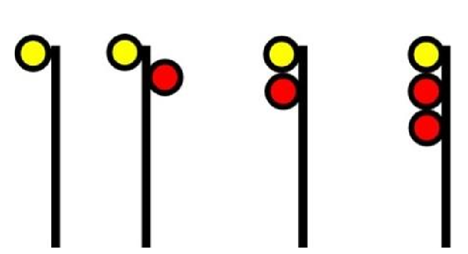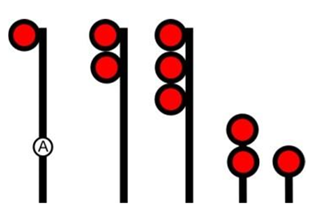TSB Rail Transportation Safety Investigation R19W0002 Train collision near Portage la Prairie, Manitoba in January 2019
Railway terminology
Railway signal indications: Signal indications are lights displayed beside or over the tracks that indicate to train crews how to proceed. Similar to traffic lights that govern the operation of roadway vehicle traffic, in signalled territory, a progression of wayside railway signal indications govern train movements on railway tracks.
Following signal indications: The safe operation of a train is a responsibility shared between a locomotive engineer and a conductor. Each train crew member is trained to recognize and understand all signal indications that they may encounter, as specified in the Canadian Railway Operating Rules (CROR). Crew members are also expected to know the territory that they operate in, including the location of individual signals. When operating a train in signalled territory, train crews are required to follow the progression of signal indications displayed in the field and operate the train accordingly.
Train crews must communicate all signal indications observed in the field to those within hearing distance within the locomotive cab, and take appropriate action to comply with the signal indication displayed. According to CROR Rule 34, if there is uncertainty, the crew must take immediate action to ensure the safety of the movement, including stopping it in emergency, if required.
| Signal aspects displayed | CROR rules |
|---|---|
|
Rule 405—Clear Signal—Proceed (at track speed) |
|
Rule 406—Clear to Limited—Proceed, approaching next signal at limited speed (not exceeding 45 mph) |
|
Rule 411—Clear to Stop—Proceed, preparing to stop at next signal |
|
Rule 439—Stop—Unless required to clear a switch, crossing, controlled location, or spotting passenger equipment on station platform, a movement not authorized by Rule 564 must stop at least 300 feet in advance of the Stop signal. |
Enhanced train control: is a system that automatically intervenes to slow or stop a train in the event that the operating crew does not respond appropriately to a signal displayed in the field. A fully functioning enhanced train control system would prevent train-to-train collisions, overspeed derailments, incursions into work zones, and movement of a train through a switch left in the wrong position. It would also offer a physical fail-safe defence against operating crew errors that are influenced by fatigue or other factors.
Key routeFootnote 1: is any track which, over a period of one year, has carried 10,000 or more loaded tank cars or loaded intermodal portable tanks containing dangerous goods.
Key trainFootnote 2: an engine with cars that includes:
- 1 or more loaded tank cars of Toxic Gases (Class 2.3) that are toxic by inhalation subject to Special Provision 23 of the Transportation of Dangerous Goods Regulations; or
- 20 or more loaded tank cars or loaded intermodal portable tanks, or any combination, containing dangerous goods.
Trip Optimizer (TO): A system that functions similarly to a car’s cruise control system which integrates global positioning system (GPS) information, track profile information and train characteristics. TO is activated and operated by the locomotive engineer (LE) using the Smart Display Integrated System (SDIS) display screen and the screen soft keys. Once activated, TO automatically maintains the train’s speed with minimal throttle manipulation and controls dynamic braking functions. The LE monitors the TO SDIS screen in order to ensure the train’s safe operation and to resume manual control when required.
The implementation of TO is an industry initiative and not a regulatory requirement. The use of TO reduces the potential for train crew errors while maximizing fuel conservation. The system assumes all signals are “Clear” and does not recognize or respond to any signal indications.



